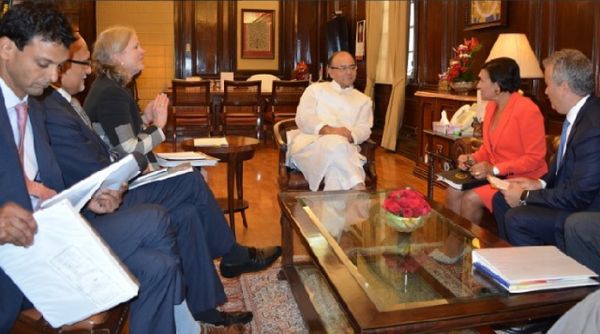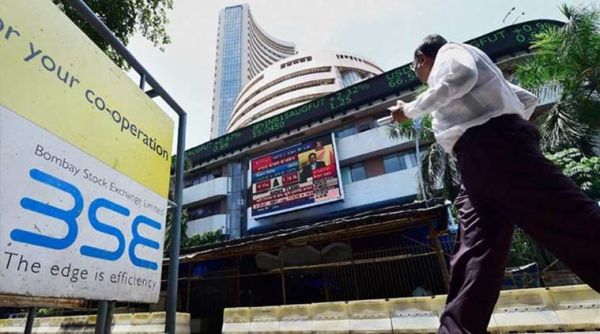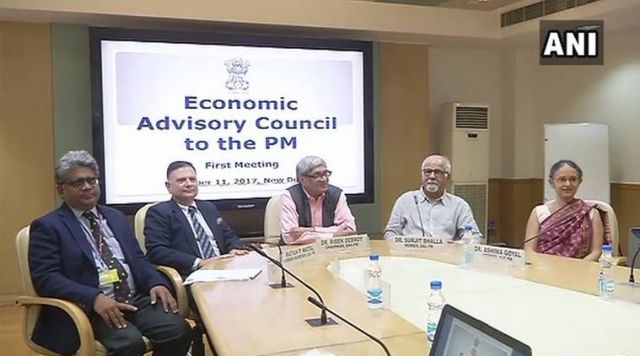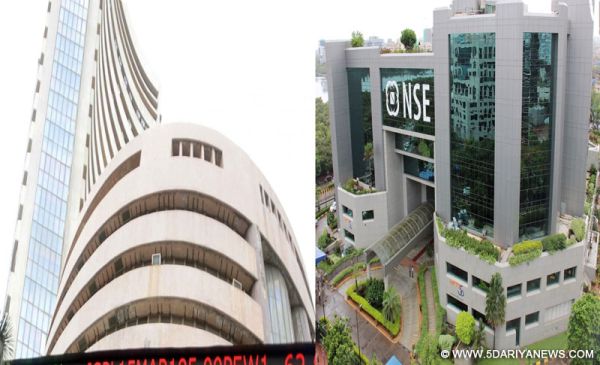
by admin | May 25, 2021 | Corporate, Corporate Governance, Economy, News, Politics
 Washington : Finance Minister Arun Jaitley on Friday said the slowdown effect of demonetisation and GST roll-out on the Indian economy has played out and the country’s growth is now headed towards being more balanced and sustainable.
Washington : Finance Minister Arun Jaitley on Friday said the slowdown effect of demonetisation and GST roll-out on the Indian economy has played out and the country’s growth is now headed towards being more balanced and sustainable.
“The Indian economy is poised for strong, sustainable and balanced growth backed by the government’s strong focus on implementing structural reforms.
“There is clear evidence now that slowdown effect of demonetisation and GST has now more or less played out,” Jaitley said at an interactive seminar here on ‘India Opportunity’ organised by the Federation of Indian Chambers of Commerce and Industry (Ficci).
“The implementation of the Goods and Services Tax (GST) from July 1 and its gradual complete transition, follow-up to demonetisation and enacting other structural reforms by the government would take the economy towards higher growth trajectory,” he added.
Jaitley is currently on a one-week official tour to Washington D.C. to attend the annual meetings of the International Monetary Fund (IMF) and the World Bank and other associated meetings.
He is accompanied by Reserve Bank of India Governor Urjit Patel and Economic Affairs Secretary Subhash Chandra Garg.
The Finance Minister spoke on the bold reforms carried out in India which now have created impressive opportunities in infrastructure assets resolution under the Insolvency and Bankruptcy Code (IBC) process and in the financial sector, the Finance Ministry said in a statement.
Further, he stated that foreign direct investment (FDI) flows to India have increased in 2016-17 over 2015-16, indicating improved global confidence in the Indian economy.
He also spoke about the interface between the global and the Indian economy, national investments and the Infrastructure Fund and reform initiatives of the government, especially to improve ease of doing business.
—IANS

by admin | May 25, 2021 | Economy, Markets, News
 Mumbai : Paring the previous day’s losses, key Indian equity indices closed on a higher note on Thursday buoyed by positive global cues and intense buying activity during the last hour of trade.
Mumbai : Paring the previous day’s losses, key Indian equity indices closed on a higher note on Thursday buoyed by positive global cues and intense buying activity during the last hour of trade.
Index heavyweights like Reliance Industries (RIL), Tata Consultancy Services (TCS), Sun Pharma, Axis Bank and Hindustan Unilever, among others, aided in the upward trajectory of the indices, according to market observers.
The 30-scrip Sensitive Index (Sensex) of the BSE closed above the psychologically important 32,000-mark, which was breached for the first time on July 13.
The Sensex closed at 32,182.22 points — up 348.23 points, or 1.09 per cent — after touching a high of 32,209.03 points and a low of 31,813.67 during intra-day trade.
The wider Nifty50 of the National Stock Exchange (NSE) surged by 111.60 points, or 1.12 per cent, to close at 10,096.40 points.
“After showing decline in the last session, Nifty shifted into a sharp upmove and closed the day higher by around 112 points, closing near the day’s high,” Deepak Jasani, Head – Retail Research, HDFC Securities, told IANS.
“Technically, the Nifty by rising sharply today has nullified the negative pattern created in the last session. This is a positive indication, and one may expect further upmove in the next session,” Jasani asserted.
In terms of the broader markets, the S&P BSE mid-cap index rose by 0.98 per cent, while the small-cap index gained 1.15 per cent.
Vinod Nair, Head of Research, Geojit Financial Services, said: “Market regained from yesterday’s loss and stayed close to 10,100-mark ahead of economic data, inflation and IIP (Index of Industrial Production) later during the day.”
“Good demand on consumer stocks on arrival of festival season and ecstasy on pharma stocks amid some positive regulatory approvals fuelled the market. Investor’s expectation on some tail winds in IT stocks ahead of results kept the counter busy,” Nair added.
On the currency front, the rupee strengthened by six paise to close at 65.08-09 against the US dollar from its previous close at 65.14-15.
In terms of investments, provisional data with the exchanges showed that foreign institutional investors (FIIs) sold scrips worth Rs 668.13 crore while domestic institutional investors (DIIs) purchased stocks worth Rs 872.54 crore.
According to sources, RIL, the most valued company on BSE in terms of market capitalisation, touched its new high of Rs 876.20 per share on an intra-day basis.
On a closing basis, the market capitalisation of the company stood at Rs 5,52,515.10 crore, as shown on the BSE side.
“Shares of Reliance Industries rallied over four per cent to hit its record high of Rs 875 ahead of its September quarter earnings due tomorrow (Friday),” said Dhruv Desai, Director and Chief Operating Officer of Tradebulls.
“Top gainers on the NSE were Hindalco, Infratel and Reliance Industries, while on the decline were Bharti Airtel, Ultratech Cement and Indian Oil Corporation,” Desai told IANS.
All the 19 sub-indices of the BSE ended in the green.
Sector-wise, the S&P BSE metal index surged by 266.16 points, followed by banking index by 257.27 points and automobile index by 245.75 points.
Major Sensex gainers on Thursday were: RIL, up 3.82 per cent at Rs 872.50; Sun Pharma, up 2.59 per cent at Rs 539.40; TCS, up 1.92 per cent at Rs 2,548.55; Axis Bank, up 1.77 per cent at Rs 524.65; and Hindustan Unilever, up 1.71 per cent at Rs 1,238.20.
Major Sensex losers were: Bharti Airtel, down 0.83 per cent at Rs 400.05; Coal India, down 0.46 per cent at Rs 282.40; Infosys, down 0.37 per cent at Rs 927.15; Asian Paints, down 0.03 per cent at Rs 1,160.10; and Power Grid, down 0.02 per cent at Rs 202.70.
—IANS

by admin | May 25, 2021 | Economy, Markets, News

Photo: Reuters
New Delhi : Even as retail inflation in India stagnated in September with a marginal drop in the food prices, the Index of Industrial Production (IIP) for August showed that factory output grew 4.3 per cent against the same month last year on the back of robust mining and electricity sector growth, official data showed on Thursday.
According to the Ministry of Statistics and Programme Implementation, September’s consumer price index (CPI) inflation remained static at 3.28 per cent as compared to August.
On a sequential basis, the country’s Consumer Food Price Index (CFPI) dropped to 1.25 per cent during the month under review when compared to 1.52 per cent in August 2017.
However, on a year-on-year (YoY) basis, the country’s September retail inflation was lower than the 4.39 per cent CPI rate reported for the corresponding month of last year.
The drop in retail inflation on a YoY basis was due to a fall in the prices of food items like pulses, eggs and spices. Vegetables in September became costlier by 3.92 per cent, while cereals prices rose by 3.70 per cent.
As against the 4.3 per cent growth in August, manufacturing output in the country in July 2017 had grown marginally by 1.2 per cent as compared to the corresponding month of last year.
As per the new IIP, with the revised base year of 2011-12, factory output had declined by (-)0.1 per cent during June due to a drop in manufacturing, from a rise of 2.80 per cent reported for May this year.
The cumulative growth for the period April-August 2017 was at a much lower 2.2 per cent, over the corresponding period of last year.
Data released by the Central Statistics Office (CSO) showed that the August growth was partly led by a revival in electricity, which grew at 8.3 per cent over the same month last year.
Manufacturing output, which has the maximum weightage in the overall index, grew at 4.3 per cent in August, as against 5.5 per cent during the same month of last year.
Mining output during the month in consideration recorded impressive growth of 9.4 per cent, as compared to the decline in August last year at (-)4.3 per cent.
Among the six use-based classification groups, the output of primary goods grew by 7.1 per cent, consumer non-durables by 6.9 per cent and infrastructure or construction goods by 2.5 per cent.
Both capital goods and consumer durables recovered from last month’s decline to grow in August at 5.4 per cent and 1.6 per cent, respectively.
In contrast, the output of intermediate goods declined by (-)0.2 per cent.
“In terms of industries, 10 out of the 23 industry groups in the manufacturing sector have shown positive growth during the month of August 2017 as compared to the corresponding month of the previous year,” the CSO said.
“The industry group ‘Manufacture of computer, electronic and optical products’ has shown the highest positive growth of 24.9 per cent, followed by 16.5 per cent in ‘Manufacture of pharmaceuticals, medicinal chemical and botanical products. On the other hand, the industry group ‘Manufacture of furniture’ has shown the highest negative growth of (-)16.0 per cent followed by (-)15.1 per cent in ‘Manufacture of tobacco products’ and (-)1.4 percent in ‘Printing and reproduction of recorded media’,” it added.
Industry welcomed the numbers indicating a rebound in industrial growth.
“Rebound in IIP is inspiring after a slowdown in the months of June 2017 and July 2017 vis-a-vis destocking and teething problems of GST,” President PHD Chamber Gopal Jiwarajka said in a statement here.
“Industrial activity shrugged off the weakness of past few months and put up a strong performance in August, suggesting that GST-related disruptions could have somewhat settled,” rating agency CRISIL said in a statement.
“In the months ahead, inflation could see an upside from some bump up in oil prices, and higher household spending led by (i) implementation of farm loan waiver and (ii) an expected upward revision in salary and allowances of state government employees,” it added.
—IANS

by admin | May 25, 2021 | Economy, Employment, News, Politics
 New Delhi : With the economy slowing down and joblessness becoming a major issue, the newly-constituted Economic Advisory Council to Prime Minister Narendra Modi on Wednesday identified 10 major priority areas including accelerating economic growth and employment over the next six months.
New Delhi : With the economy slowing down and joblessness becoming a major issue, the newly-constituted Economic Advisory Council to Prime Minister Narendra Modi on Wednesday identified 10 major priority areas including accelerating economic growth and employment over the next six months.
The 10 themes were identified during the first meeting of the council chaired by NITI Aayog Member Bibek Debroy. The council was reconstituted a fortnight ago in what was seen as the government acknowledging for the first time the problem of economic slowdown.
Apart from giving recommendations to the Prime Minister on these issues, the EAC-PM would also focus on the next budget preparation over the coming months, Debroy told reporters here after the meeting.
During the meeting, Chief Economic Advisor Arvind Subramanian focused attention on accelerating economic growth — including investments and exports — using a combination of different policy levers.
The council took stock of the current economic, fiscal and monetary policy environment and resolved to focus on key identified issues.
“We have identified 10 themes that we would initially work on till we have our next meeting one month from now,” Debroy said.
“The 10 themes identified are economic growth, employment and job creation, informal sector and integration, fiscal framework, monetary policy, public expenditure, institutions of economic governance, agriculture and animal husbandry, patterns of consumption and production, and the social sector,” he added.
Debroy said the entire thrust of the council would be on specific implementable recommendations, which would distinguish it from other bodies.
“Our view will be on specific thing you can change,” he said.
The council members would come up with a report in the coming months through consultative processes with ministries, states, private sector and other stakeholders.
They would also come out with specific issue papers to address key concerns, a statement said.
—IANS

by admin | May 25, 2021 | Banking, Economy, Markets, News
 Mumbai : Breaking a three-day gaining streak, key Indian equity indices closed on a lower note on Wednesday as investors booked profits ahead of the release of important macro-data as well as quarterly earnings results of corporates, according to market observers.
Mumbai : Breaking a three-day gaining streak, key Indian equity indices closed on a lower note on Wednesday as investors booked profits ahead of the release of important macro-data as well as quarterly earnings results of corporates, according to market observers.
Besides, heavy selling pressure in metal, banking and automobile stocks, along with outflow of foreign funds, kept investors’ sentiments subdued.
The wider Nifty50 of the National Stock Exchange (NSE) once again slipped below the psychologically important 10,000-mark — which was reclaimed on Tuesday — to close lower by 32.15 points, or 0.32 per cent, at 9,984.80 points.
The 30-scrip Sensitive Index (Sensex) of the BSE, which opened higher at 31,975.59 points, closed at 31,833.99 points — down 90.42 points, or 0.28 per cent, from its previous close.
The BSE market breadth was bearish — 1,840 declines and 918 advances.
“Nifty showed a bout of volatility in today’s session and closed the day lower by 32 points. Nifty showing sharp intra-day weakness from the highs today is opening up the possibility for more weakness for the coming sessions,” Deepak Jasani, Head – Retail Research, HDFC Securities, told IANS.
“Sectorally, except IT and energy, all the sectors of broader market have closed in the negative. Major Asian markets have ended on mixed trend, while European indices like FTSE 100 and CAC 40 traded lower and DAX traded higher.”
In terms of the broader markets, the S&P BSE mid-cap index fell by 0.82 per cent, while the small-cap index closed lower by 1.08 per cent.
Vinod Nair, Head of Research, Geojit Financial Services, said: “The market failed to hold the opening positive momentum as profit booking emerged towards close due to cautiousness on tomorrow’s (Thursday) CPI (Consumer Price Index) and IIP (Index of Industrial Production) data.”
“Additionally, earnings season will kick-start tomorrow with the result of IT heavyweights and market will take direction from the expectation and the actual numbers,” said Nair.
IT major Tata Consultancy Services (TCS) is expected to be the first blue-chip company to come out with its second quarter (Q2) results on October 12.
“September quarter earnings season is expected to be subdued due to the impact of the Goods and Services Tax (GST). Market heavyweights TCS and Reliance Industries are slated to post results later this week,” said Dhruv Desai, Director and Chief Operating Officer of Tradebulls.
On the currency front, the rupee strengthened by 13-14 paise to close at 65.14-15 against the US dollar from its previous close at 65.28.
In terms of investments, provisional data with the exchanges showed that foreign institutional investors (FIIs) sold scrips worth Rs 107.95 crore while domestic institutional investors (DIIs) purchased stocks worth Rs 233.80 crore.
Sector-wise, the S&P BSE banking index declined by 264.31 points, followed by metal index by 202.63 points and automobile index by 158.88 points.
On the other hand, the S&P BSE oil and gas index rose by 170.86 points, telecom index by 38.33 points and Teck index by 37.36 points.
Major Sensex gainers on Wednesday were: Bharti Airtel, up 5.04 per cent at Rs 403.40; TCS, up 1.66 per cent at Rs 2,500.50; Wipro, up 1.43 per cent at Rs 290.65; Mahindra and Mahindra, up 1.30 per cent at Rs 1,319.70; and Hindustan Unilever, up 0.32 per cent at Rs 1,212.
Major Sensex losers were: Tata Motors, down 2.02 per cent at Rs 415.25; State Bank of India, down 1.97 per cent at Rs 251.60; Dr. Reddy’s Lab, down 1.47 per cent at Rs 2,374.90; Lupin, down 1.42 per cent at Rs 1,045.50; and Tata Steel, down 1.40 per cent at Rs 681.
—IANS

 Washington : Finance Minister Arun Jaitley on Friday said the slowdown effect of demonetisation and GST roll-out on the Indian economy has played out and the country’s growth is now headed towards being more balanced and sustainable.
Washington : Finance Minister Arun Jaitley on Friday said the slowdown effect of demonetisation and GST roll-out on the Indian economy has played out and the country’s growth is now headed towards being more balanced and sustainable.



